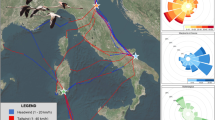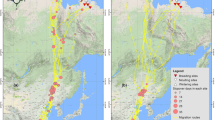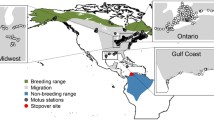Abstract
In a field experiment on the island of Helgoland (southeast North Sea), we investigated whether migration strategy or competition between the sexes cause the differential timing of spring migration of male and female northern wheatears (Oenanthe oenanthe) (males migrating earlier). The study included two subspecies, heading towards Greenland/Iceland and Scandinavia, respectively, and is based on colour-ringing and remote weighing of individuals. Despite food offered ad libitum, most Scandinavian birds left the island on the day of arrival or stayed only 1–3 days, whereas more than half of Greenlandic/Icelandic birds stayed for up to 12 days and refuelled rapidly. In the latter subspecies, males showed a positive correlation of departure fuel load and fuel deposition rate, resembling time-minimizers in optimal migration theory. In contrast, females departed irrespective of fuel deposition rate, with an approximately constant level of fuel stores. This level was lower than in males, but sufficient to enable by-passing of stopover sites en route, allowing us to regard females as time-minimizers also. Since females are not able to reach Greenland without additional refuelling elsewhere and males appeared to have a larger potential for by-passing stopover sites, time-selection seems to be more pronounced in males and may be the reason for earlier migration of males. Intraspecific aggressive interactions between colour-ringed birds were predominantly won by the initiator, by males and by larger birds, whereas fuel load and subspecies did not affect the outcome. Although compared to females, males were more often dominant at the feeding stations or held territories, refuelling patterns could not be explained by dominance. Subordinate or non-territorial birds did not refuel at a lower rate or depart with lower fuel loads than dominant or territorial birds. In non-territorial birds, the restricted access to feeding stations was made up with larger doses of food taken per visit, leading to the same energy intake as that of dominant and territorial birds. Therefore, competition during stopover could be eliminated as the reason for differential timing of migration of male and female wheatears, but this result may be species-specific.






Similar content being viewed by others
References
Alerstam T, Hedenström A (1998) The development of bird migration theory. J Avian Biol 29:343–369
Alerstam T, Lindström Å (1990) Optimal bird migration: the relative importance of time, energy, and safety. In: Gwinner E (ed) Bird migration: physiology and ecophysiology. Springer, Berlin Heidelberg New York, pp 331–351
Bairlein F (1991) Body mass of garden warblers (Sylvia borin) on migration: a review of field data. Vogelwarte 36:48–61
Bernhoft-Osa A (1958) Das Vorkommen von Oenanthe oe. leucorrhoa (Gmel.) in den Zugzeiten auf Jaeren in Süd-Norwegen. Sterna 3:13–18
Carpenter FL, Hixon MA, Temeles EJ, Russell RW, Paton DC (1993) Exploitative compensation by subordinate age-sex classes of migrant rufous hummingbirds. Behav Ecol Sociobiol 33:305–312
Chandler CR, Mulvihill RS (1990) Interpreting differential timing of capture of sex classes during spring migration. J Field Ornithol 61:85–89
Cristol DA (1995) Early arrival, initiation of nesting, and social status: an experimental study of breeding female red-winged blackbirds. Behav Ecol 6:87–93
Currie D, Thompson DBA, Burke T (2000) Patterns of territory settlement and consequences for breeding success in the northern wheatear Oenanthe oenanthe. Ibis 142:389–398
Delingat J, Dierschke V (2000) Habitat utilization by northern wheatears (Oenanthe oenanthe) stopping over on an offshore island during spring migration. Vogelwarte 40:271–278
Dierschke V, Delingat J (2001) Stopover behaviour and departure decision of northern wheatears, Oenanthe oenanthe, facing different onward non-stop flight distances. Behav Ecol Sociobiol 50:535–545
Dierschke V, Delingat J (2003) Stopover of northern wheatears Oenanthe oenanthe at Helgoland: where do the migratory routes of Scandinavian and Nearctic birds join and split? Ornis Svec 13:53–61
Dierschke V, Delingat J, Schmaljohann H (2003) Time allocation in migrating northern wheatears (Oenanthe oenanthe) during stopover: is refuelling limited by food availability or metabolically? J Ornithol 144:33–44
Forstmeier W (2002) Benefits of early arrival at breeding grounds vary between males. J Anim Ecol 71:1–9
Francis CM, Cooke F (1986) Differential timing of spring migration in wood warblers (Parulinae). Auk 103:548–556
Gauthreaux SA (1982) The ecology and evolution of avian migration systems. In: Farner DS, King JR, Parkes KC (eds) Avian biology, vol 6. Academic, New York, pp 93–168
Gudmundsson GA, Lindström Å, Alerstam T (1991) Optimal fat loads and long-distance flights by migrating Knots Calidris canutus, Sanderlings C. alba and Turnstones Arenaria interpres. Ibis 133:140–152
Hantge E (1958) Frühjahrsdurchzug des Steinschmätzers (Oenanthe oenanthe) bei Heidelberg. Vogelwelt 79:149–154
Hasselquist D (1998) Polygyny in great reed warblers: a long-term study of factors contributing to male fitness. Ecology 79:2376–2390
Hedenström A, Alerstam T (1997) Optimal fuel loads in migratory birds: distinguishing between time and energy minimization. J Theor Biol 189:227–234
Hedenström A, Pettersson J (1986) Differences in fat deposits and wing pointedness between male and female willow warblers caught on spring migration at Ottenby, SE Sweden. Ornis Scand 17:182–185
Jacobs J (1974) Quantitative measurement of food selection. Oecologia 14:413–417
Jenni L, Winkler R (1989) The feather-length of small passerines: a measurement for wing-length in live birds and museum skins. Bird Study 36:1–15
Kaiser A (1993) A new multi-category classification of subcutaneous fat deposits of songbirds. J Field Ornithol 64:246–255
Kelly JF, DeLay LS, Finch DM (2002) Density-dependent mass gain by Wilson’s warblers during stopover. Auk 119:210–213
Ketterson ED, Nolan V (1983) The evolution of differential bird migration. In: Johnston RF (ed) Current ornithology, vol 1, pp 357–402
Lindström Å (1991) Maximum fat deposition rates in migrating birds. Ornis Scand 22:12–19
Lindström Å, Alerstam T (1992) Optimal fat loads in migrating birds: a test of the time-minimization hypothesis. Am Nat 140:477–491
Lindström Å, Hasselquist D, Bensch S, Grahn M (1990) Asymmetric contests over resources for survival and migration: a field experiment with bluethroats. Anim Behav 40:453–461
Lindström Å, Klaassen M, Piersma T, Holmgren N, Wennerberg L (2002) Fuel stores of juvenile waders on autumn migration in high arctic Canada. Ardea 90:93–101
Mabey SE, Woodrey MS (1999) An experimental test of intersexual competition during migration. Ostrich 69:198
Maitav A, Izhaki I (1994) Stopover and fat deposition by blackcaps Sylvia atricapilla following spring migration over the Sahara. Ostrich 65:160–166
Marra PP, Hobson KA, Holmes RT (1998) Linking winter and summer events in a migratory bird by using stable-carbon isotopes. Science 282:1884–1886
Møller AP (1994) Phenotype-dependent arrival time and ist consequences in a migratory bird. Behav Ecol Sociobiol 35:115–122
Moore FR, Yong W (1991) Evidence of food-based competition among passerine migrants during stopover. Behav Ecol Sociobiol 28:85–90
Moore FR, Kerlinger P, Simons TR (1990) Stopover on a Gulf coast barrier island by spring trans-Gulf migrants. Wilson Bull 102:487–500
Moore FR, Mabey S, Woodrey M (2003) Priority access to food in migratory birds: age, sex and motivational asymmetries. In: Berthold P, Gwinner E, Sonnenschein E (eds) Avian migration. Springer, Berlin Heidelberg New York, pp 281–292
Morris SR, Glasgow JL (2001) Comparison of spring and fall migration of American redstarts on Appledore Island, Maine. Wilson Bull 113:202–210
Myers JP (1981) A test of three hypotheses for latitudinal segregation of the sexes in wintering birds. Can J Zool 59:1527–1534
Ottosson U, Sandberg R, Pettersson J (1990) Orientation cage and release experiments with migratory wheatears (Oenanthe oenanthe) in Scandinavia and Greenland: the importance of visual cues. Ethology 86:57–70
Pennycuick CJ (1989) Bird flight performance: a practical calculation manual. Oxford University Press, Oxford
Pennycuick CJ (2002) Flight 1.12. C. Pennycuick
Perrins CM (1970) The timing of birds’ breeding seasons. Ibis 112:242–255
Rappole JH, Warner DW (1976) Relationships between behavior, physiology and weather in avian transients at a migration stopover site. Oecologia 26:193–212
Sandberg R (1996) Fat reserves of migrating passerines at arrival on the breeding grounds in Swedish Lapland. Ibis 138:514–524
Sandberg R, Moore FR (1996) Fat stores and arrival on the breeding grounds: reproductive consequences for passerine migrants. Oikos 77:577–581
Schaub M, Jenni L (2000) Fuel deposition of three passerine bird species along the migration route. Oecologia 122:306–317
Schaub M, Jenni L (2001) Variation of fuelling rates among sites, days and individuals in migrating passerine birds. Funct Ecol 15:584–594
Schmaljohann H, Dierschke V (2005) Optimal bird migration and predation risk: a field experiment with northern wheatears Oenanthe oenanthe. J Anim Ecol 74 (in press)
Smith RJ, Moore FR (2003) Arrival fat and reproductive performance in a long-distance passerine migrant. Oecologia 134:325–331
Smith RJ, Moore FR (2004) Arrival timing and seasonal reproductive performance in a long-distance migratory landbird. Behav Ecol Sociobiol (in press)
Spina F, Pilastro A (1999) Strategy of sea and desert crossing in spring passerine migrants as suggested by the analysis of intra- and inter-specific variation of residual fat levels. Proc 22 Int Ornithol Congr Durban 1958–1976
Spina F, Massi A, Montemaggiori A (1994) Back from Africa: who’s running ahead? Aspects of differential migration of sex and age classes in Palearctic-African spring migrants. Ostrich 65:137–150
Svensson L (1992) Identification guide to European passerines, 4th edn. Stockholm
Swanson DL, Liknes ET, Dean KL (1999) Differences in migratory timing and energetic condition among sex/age classes in migrant ruby-crowned kinglets. Wilson Bull 111:61–69
Terrill SB, Berthold P (1989) Experimental evidence for endogenously programmed differential migration in the blackcap Sylvia atricapilla. Experientia 45:207–209
Visser ME, Noordwijk AJ van, Tinbergen JM, Lessells CM (1998) Warmer springs lead to mis-timed reproduction in great tits (Parus major). Proc R Soc Lond B 265:1867–1870
Weber TP, Fransson T, Houston AI (1999) Should I stay or should I go? Testing optimality models of stopover decisions in migrating birds. Behav Ecol Sociobiol 46:280–286
Wood B (1992) Yellow wagtail Motacilla flava migration from West Africa to Europe: pointers towards a conservation strategy for migrants on passage. Ibis 134 [Suppl 1]:66–76
Woodrey MS (2000) Age-dependent aspects of stopover biology of passerine migrants. Stud Avian Biol 20:43–52
Yong W, Finch DM, Moore FR, Kelly JF (1998) Stopover ecology and habitat use of migratory Wilson’s Warblers. Auk 115:829–842
Acknowledgements
Assistance during the field work was provided by R. Morgenstern and A. Walter. Technical support was obtained from R. Nagel. We are much indebted to F. Bairlein for initiating the study. He, N. Anthes, L. Jenni and an anonymous referee commented on the manuscript. The study was financially supported by the “Freunde und Förderer der Inselstation der Vogelwarte Helgoland e.V.” and by the Deutsche Forschungsgemeinschaft (BA 816/15-1). The experiments comply with the current laws of Germany and Schleswig-Holstein.
Author information
Authors and Affiliations
Corresponding author
Additional information
Communicated by W. Wiltschko
Rights and permissions
About this article
Cite this article
Dierschke, V., Mendel, B. & Schmaljohann, H. Differential timing of spring migration in northern wheatears Oenanthe oenanthe: hurried males or weak females?. Behav Ecol Sociobiol 57, 470–480 (2005). https://doi.org/10.1007/s00265-004-0872-8
Received:
Revised:
Accepted:
Published:
Issue Date:
DOI: https://doi.org/10.1007/s00265-004-0872-8




